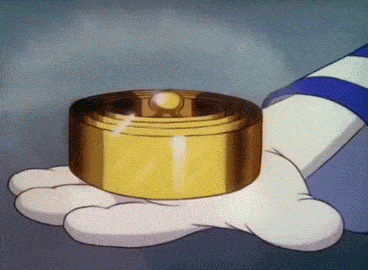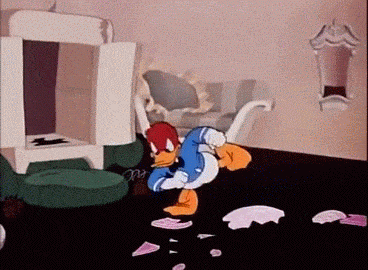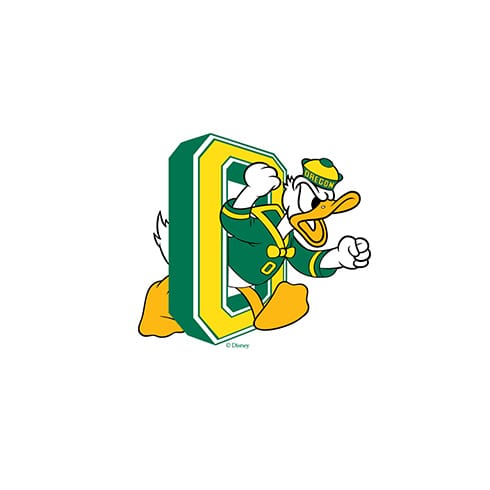Royal College of Art Critical Writing student Marianne Hanoun lets us in on the history behind the University of Oregon’s association with Disney’s Donald Duck.
On October 27th 1954 Walt Disney addressed a television audience of over a million viewers, and shared with them his own wish: ‘I only hope that we never lose sight of one thing – that it was all started by a mouse.’ Mickey Mouse undoubtedly provided the foundation on which the Disney brand was built, and after his successful debut in 1928, it was not long before other characters began joining the Disney stable; Goofy made his first appearance in 1932, and was shortly followed by a belligerent, ill-tempered duck two years later. I have long admired Donald’s tenacity, and will one day argue for his recognition as a design hero, based solely on his ‘What’s the big idea?’ catchphrase. But for now I want to momentarily draw the limelight away from Mickey, and focus it on Donald and his foray into the sporting world.
Treading a fine line between the corporate and the collegiate, the University of Oregon is the first and only university ever licensed to use the image of Donald as their sporting mascot. While the logo in this form was phased out in the early 1990s, UO’s affiliation with Disney’s Donald has played an important role in the shaping of the university’s brand, becoming a part of its intriguing, but admittedly complex history.
With the help of sports journalists, UO’s sports teams – originally known as the ‘Webfoots’, and later the ‘Webfooted Ducks’ – finally became the ‘Ducks’ in 1926, making for a stronger-sounding moniker against other rival teams. From the 1920s through to the 1940s UO even had a live duck mascot called Puddles, who underwent five reincarnations before being retired indefinitely. It was around this time that cartoon drawings of Puddles began to appear in student publications, striking an incredibly close resemblance to Donald, and causing alarm bells to ring in the Disney building. A deal was soon made in 1947 on the basis of a handshake between UO’s athletic director Leo Harris and Walt Disney himself, allowing the university to use Donald’s likeness, and making him the official sporting mascot for UO. To this day, no contract has been found to confirm this; instead, UO stands by a black and white photograph provided by Harris, which shows Disney wearing a letterman jacket emblazoned with the Donald-like logo as proof of the agreement.

From the Webfoots to Puddles, and from Donald to the Ducks, the breeding of UO’s mascot has evidently been several years in the making. In fact, most Oregonians do not distinguish the character as Donald, but refer to him simply as the ‘Duck’, while others still regard him as Puddles. (Strangely enough, this is not uncommon for Donald, who seems to persistently suffer from identity crisis issues – not least due to being repeatedly confused with Warner Brothers’ Daffy Duck). The character is unmistakably Donald but with minor, yet key differences mainly in colour and costume. Designed by Disney cartoonists, at first glance the logo seems unassuming; typically showcasing the mascot alongside an acronym of the university’s name in a varsity-style typeface. Yet the overall rendering of the character comes across as somewhat crude with its varying line widths and unsophisticated detailing in the bow and collar. By way of highlighting the Duck’s primary features, the face, fists and tail have been intentionally outlined in thicker strokes, but consequently make the logo feel clumsy and unbalanced. When Harris shook hands with Disney, UO may have gained an official drawing of their mascot, but the real value resided in what Donald was able to offer in terms of personality and tone.
Donald did more than merely lend UO his likeness; he carried a sense of spirit that the university could inherit – using his image not as a cartoon carbon copy, but as a template on which to build upon. It is not surprising that UO was not the only institution inspired to use his image. In the 1940s, Argentinian cartoonist Lorenzo Mollas used Donald as the mascot for the Brazilian sports club Botafogo. No contract was drawn up and a new mascot took his place, but Donald continues to fly under the radar as their unofficial mascot. With his doughy build and tightly-clenched fists, the character paints himself as the unsuspecting underduck – a far cry from the brawny mascots of other universities that boasted cougars or bulls. Donald captured a certain subtle irony; ducks may appear meek in contrast to cougars but Donald – although persistently beleaguered by life’s frustrations – had a willingness to persevere and a fighting attitude. What he lacked in musculature, he more than made up for in a dangerous mix of fury and pride.

During the 1930s—40s, Donald’s popularity grew to rival and later overtake Mickey’s success, ultimately leading him to star in more feature films than the celebrated mouse. Appearing in cartoons as an antidote to Mickey’s wholesomeness, Donald’s quick temper and determined attitude allowed him to become an outlet for irreverence and anger. His hot-headedness and nerve struck true with an audience that were also suffering from life’s daily difficulties, and out of the famous trio of the mouse, dog and duck, it is Donald that feels the most human.
His hallmark character traits also translated easily into humour, providing a cathartic dose of comic relief. In The Hockey Champ (1939), we see him boasting his hockey credentials, as he pulls out a conveniently and ever-so-cartoony collapsible golden trophy, that he proudly parades in front of his nephews. But his pride is short-lived when – much like his other incompetent sporting attempts – it all ends in disaster. Regardless, Donald always chooses fight over flight, and exhibits a charming inventiveness when he is challenged, which is always enjoyable to watch unfold. As he charges through the traditional varsity ‘O’ of the university logo, it is not difficult to envisage him tripping up over the letterform’s large bottom ledge, before finding his face on the floor and subsequently escalating into a crescendo of sheer rage and destruction.
When Disney died in 1966, and the company found there to be no official contract for Donald’s use, a formal agreement was put into writing in 1973 – but this time specifying that the live incarnation of the mascot must adequately represent Donald’s character. This was later excluded from the contract in 2010 on the basis that the costume no longer held enough resemblance to be of any harm to his image. It was only when the mascot stopped pretending to be Donald, that it could finally become the Duck.
By walking out of the logo and into a fluffy, feathered costume on the sports field, Donald helped UO transition from Disney to Duck. Although the original 1947 mark is no longer in use, UO’s development of the Duck is on-going. The current interpretation of the character – a more streamlined side-profile version of the Duck, with thicker outlines and a more defined scowl – was made to complement the newly designed ‘O’ logo.
Oregon’s Duck has since become an icon in his own right. Despite being visually dissimilar to the current Duck, the live mascot has maintained an enduring affinity with Oregonians that has kept him in attendance at games. The Duck now carries himself with a jock-like swagger, coaxing the crowds, starring in interviews and famously falling to his knees to complete a series of push ups after every touchdown. But he evidently still carries traces of Donald DNA, and has been seen on occasion to lose his temper – in one instance wrestling another mascot to the ground. He has also (figuratively speaking) fought off attempts at usurpation by Mandrake, or ‘Duck Vader’ – a futuristic, spandex-wearing duck mascot designed by Nike in 2002. ‘Duck Vader’ lasted only a year. Donald’s influence lives on in the costumed character made in his image who proudly paces the pitch during games. He remains an actively engaged part of UO’s sporting present and a celebratory reminder of its history that, like Donald himself, simply refuses to budge.
Acting like any true sports fan, Donald represents the sheer frustration that comes with a team’s loss, and the residual hunger for the next game. His tenacious nature and impulsive assertiveness speaks to the athlete as well as the fan left shouting at the TV or from the side lines. Looking past the tantrums, the broken crockery and the lamp-shaped holes in the wall, Donald displays heart, conviction and an unwavering belligerence that makes him a fitting symbol of fighting spirit.
cargocollective.com/MMH
Marianne Hanoun
… is a writer and designer who after graduating in graphic design from Kingston University last year, did a stint at NB Studio before heading off to the Royal College of Art to study Critical Writing in Art and Design.
Donald Duck
… was portrayed throughout his career as jealous of Mickey Mouse. After the two were initially shown as partners, by the time The Mickey Mouse Club aired on television, it was shown that Donald always wanted the spotlight. The rivalry would cause Donald some problems when, in a 1988 TV special, Mickey is cursed by a sorcerer to become unnoticed and the world believes Mickey to be kidnapped. Donald Duck is then arrested for the kidnapping of Mickey, as he is considered to be the chief suspect due to their rivalry.

